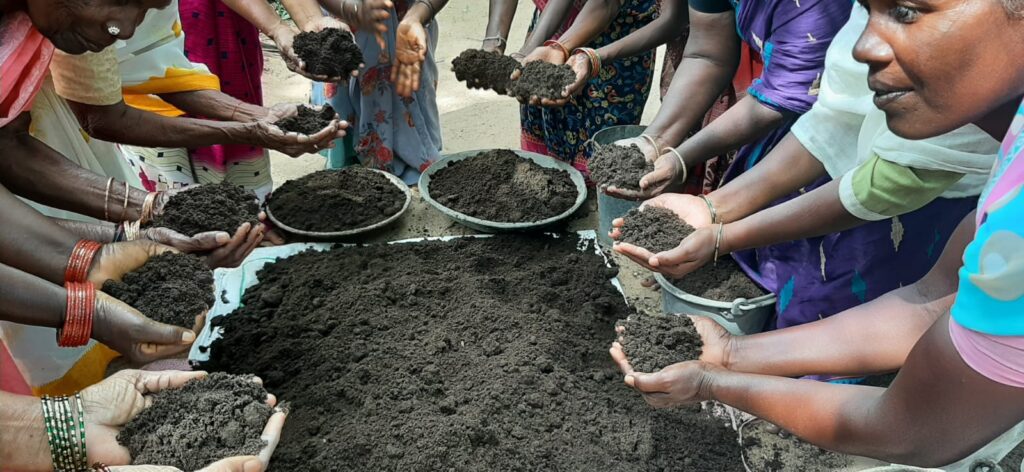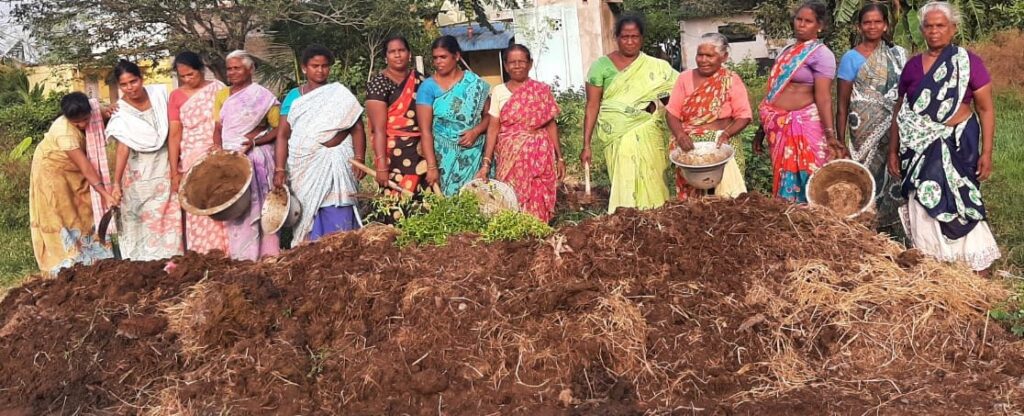(Radha’s story is part of a series of case studies on exceptional women farmers practicing agroecology. This profile is adapted from Stewards of the Fields: Women Farmers Navigating Sustainable Paths: A series of case studies of fifteen women farmers’ experiments with agroecological farming published by MAHILA KISAN ADHIKAAR MANCH.)
Women farmers, like Radha, are disproportionately affected by the climate crisis, which brings environmental changes that affect food and nutrition security, and their sources of livelihood. The invisibility of women’s labor further aggravates these adverse effects. But it is also the women who are often at the forefront of the paradigm shift that is needed to a more sustainable, low-input, and climate-resilient approach that allow them to feed their families and communities and earn a stable income–and that is agroecology.
Radha is a 45-year-old Dalit woman farmer from Thaazhavedu village in the Thiruvallur district of Tamil Nadu. A member of the SC Arunthathiyar Palayam a member of Tamil Nadu Dalit women’s movement and was trained by Society for Rural Education and Development (SRED), Radha practices agroecological farming techniques on her one-acre land that her parents owned. She started helping her parents with farming when she was 15 years old. Radha consciously chose to be a farmer, although she also does livestock rearing and backyard poultry, and expressed an interest in factory work. She also focuses on paddy harvesting and cultivating jasmine flowers such as Jathi Malli and Kundu Malli to earn an income.
A natural curiosity
Radha has been involved in agroecological farming practices and has conducted various experiments on her own farm. One of her experiments involved using natural pest controls made from locally available leaves and herbs. She mixed three varieties of leaves–those containing milk, bitter-tasting leaves, and fragrant leaves–with water and other herbs, and allowed it to ferment for 21 days before using it as a spray to control pests.

Radha also makes natural manure by utilizing waste materials such as dry leaves and locally available animal waste. This helps in enriching the soil and providing essential nutrients for plant growth. These experiments were successful and gave Radha a sense of satisfaction. Not only were they highly effective, they were also cost-efficient as she was able to easily collect the ingredients because they were readily available in her village.
However, Radha also faced challenges in her farming journey due to limited knowledge in organic practices. She struggled with preparing vermicompost and failed to multiply the earthworms effectively. She sought advice from experienced individuals and learned from their expertise, gradually understanding the nuances and eventually succeeding, turning her initial failure into a valuable learning experience.
Radha was able to start a kitchen garden, providing vegetables for her family’s consumption and sharing them with her neighbors. Along with other women farmers, she focused on cultivating seasonal crops such as millets alongside greens and vegetables that are resilient to local soil and climate conditions. They have reduced the use of outside inputs, primarily chemical fertilizers and pesticides, making their farming methods more sustainable and cost-effective. Because she learned to save organic seeds and exchange them with fellow women farmers, she was able to reduce her reliance on purchased seeds.
Radha also grew paddy on one acre of land and cultivated jasmine flowers on half an acre. Radha shares that she used 500 kg of paddy for home consumption and sold 2,400 kg in the Tiruttani mandi, selecting it because of the fixed wholesale price. She also contributed 100 kg of paddy to a seed bank. Some of the challenges she faced growing paddy include damage by cattle and rats.
Building soil and sufficiency
Radha and the women farmers actively engage in composting and soil building. Many of them also combine their farming practices with small ruminants like sheep, goats, and chickens, utilizing their manure for improved soil fertility.

The women farmers prepare two types of compost: vermicompost and compost made in pits using dry leaves, waste materials, and animal dung. These composting methods help in improving soil health and nutrient content. In terms of pest management, some women farmers use Panchakavya, a mixture of milk products and waste, while others utilize locally available leaves and herbal plants to create effective pest control solutions.
Livestock and ornamentals
Radha also engaged in the production and marketing of eggs and chicken meat. She got eggs per month, of which 5 were consumed at home, and 15 were sold in the market. Goat meat was produced once a year, with 7 kg sold in the market. Radha faced challenges such as disease and theft with these livestock products. She participated in marketing-related activities for both eggs and goat meat.
Radha also sold cow milk. Out of the daily production of 10 liters, she consumed 500 ml at home, sold 9 liters in the market, and distributed 500 ml among relatives and neighbors. The milk was marketed through a milk society and to local villagers. Radha and her husband participated in marketing activities for cow milk.
Radha also grows jasmine flowers, but this has become difficult due to a lack of rain and also pests that can destroy the flowers. The jasmine harvest was sold at the Chennai Koyambedu market and Tiruttani market, as Radha believed she could get better prices in the city market. She sold the entire 25 kg of jasmine flowers there, setting aside 100 grams to be shared with the children in the village.
Marketing
Radha and her husband work together in marketing activities. They did not interact with agents or middlemen and did not need to borrow or take a loan for Kharif marketing. However, Radha’s produce was not certified as organic, and she said there was no difference in selling prices for produce based on agroecological practices compared to chemical fertilizer/pesticide-based produce. Therefore, she had to sell it at a lower price in the same market. Radha knows about various markets at the rural/local level and urban retailers. She mentions that she cannot sell her produce on online platforms due to her lack of technical knowledge.
Conclusion
Radha’s farming journey is about exploring innovative methods, overcoming hurdles, and embracing improvements. Compared to previous years, her experience of adopting agroecological practices led to improvements such as increased biomass, better soil health, and the cultivation of new uncultivated crops. She mastered pest control using organic matter and crafted her own fertilizers. Even when faced with setbacks, she persevered. Radha’s crops flourished, showing how hard work and experimenting with new ideas can pay off.


